Tabako Bon
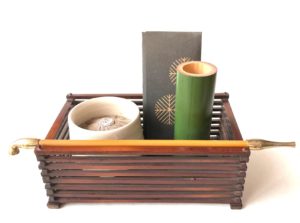
In a Tea Ceremony setting, to encourage relaxation, the host, tei-shu, 亭主, house-master, provides various smoking utensils in a tabako bon, 煙草盆, smoke-plant tray. The basic utensils are tobacco in a paper folder, tabako ire, 煙草入, a pipe, kiseru, 煙管, a lighter, hi-ire, 火入, fire-into, and a burnt ash receptacle made of green bamboo, hai-fuki, 灰吹, ash-blow.
The tabako bon, pictured above, is made of narrow strips of susu-dake, 煤竹, smoked-bamboo, that is suited to summer, as the open construction technique gives a cool breeze feeling. The box is one of a nesting pair that fit inside the other: L. 7.3 x 4.2 sun kane-jaku.
The shō-men, 正面, true-face, of the tabako bon has the hiire containing a charcoal fire on the left side of the box, and the haifuki containing water on the right side of the box, which is the same juxtaposition of the portable fu-ro, 風炉, wind-hearth, and mizu-sashi, 水指, water-indicate, of Chanoyu. According to the Eki-kyō, 易経, Change-sutra, fire on the left and water on the right locates the front in the north. This situates the person using the tabako bon as being in the north, the place of an elevated person or deity. The person who uses the pipe to smoke handles fire, and such an individual is identified as tei-shu, 亭主, house-master. The kanji for shu, 主, is composed of ō, 王, king, with a dot on the top that is identified with fire, so that the person who handles fire is master. This is the role of the person who prepares the Tea, teishu, however, that person only briefly handles fire (in the presence of the guest), but rather handles water with the hi-shaku, 柄杓, handle-ladle.
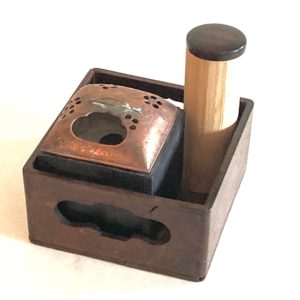
The square, domed copper lid comes from a more common tabako bon used in daily life. The lid has openwork of ume–no-hana, 梅の花, prunus-’s flower, with a two-tine matsu-ba, 松葉, pine-leaf, handle, and opening for access with the pipe to the burning charcoal: 3 sun kane-jaku square.
The pictured tabako bon is set with utensils that have lids that are familiar and typical in traditional Japan. In a humble Tearoom, the hiire and the haifuki are without lids, and so are readily useable, and one can see the fire of the burning charcoal in the hiire, and the small amount of water that is somewhat hidden in the bamboo tube. Containers are In, 陰, negative, receptive, and when shut with a lid are Yō, 陽, positive, penetrative. Fire is Yō, water is In. The lid of the hiire has openings in it, so that Yō changes to In. This is the very nature of the Eki-kyō, 易経, Change-sutra. Everything changes.
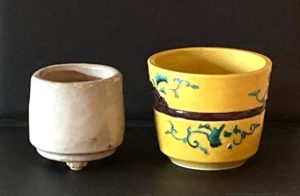
The hiire has its origins in the kō-ro, 香炉, incense-hearth, which has been a part of Buddhism for thousands of years. Tabako provided some benefits when smoked, which it does to the present. As with some things, through abuse it can become a menace. Since its introduction to Japan in the 16th century, the Japanese enjoyed smoking tobacco, and fashioned a multitude of paraphernalia for it, kept in a box. The above hiire lid is from one of those tabako box sets. The partially open lid prevents an excess of oxygen from causing the charcoal to burn more quickly. Because of tobacco’s wild popularity, in an active environment, the lid helps keep things from falling in and catching fire. Tobacco had lost its medicinal role.
Rikyū contributed to the pursuit of the recently introduced tobacco, and included it in Chanoyu. Tea, like anything, can cause discomfort when overdone. Tobacco was thought of as medicinal, and therefore was taken in a dose, i-ppuku, 一服, one-dose. The host begins a Tea preparation with the expression, “I-ppuku sashi-agemasu”, 一服差し上げる, one-dose give-up. During a Chaji, a small amount of tobacco packed into the very small bowl of the kiseru/pipe provides three puffs each for four guests. Ippuku – three puffs of tobacco, is like ippuku – three sips of Tea. These are the doses.
In the realm of incense appreciation, Kō-dō, 香道, Incense-way, a person holds the incense burner and breathes in the fragrance three times. Just like tea and tobacco. In Kōdō, an individual ‘listens’ to incense, rather than ‘smells’ it; kō wo kiku, 香を聞く, incense to listen: mon-kō, 聞香, listen-incense.
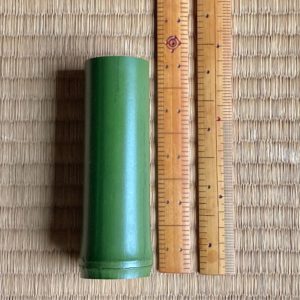
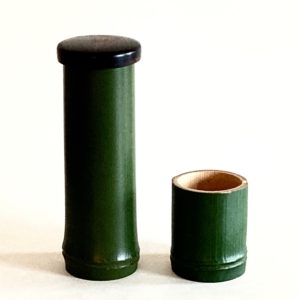
It is interesting to note that the haifuki has a lid, which makes it Yō, and the inverted bamboo is a lid-place, futa-oki. The inverted bamboo futaoki relates to other futaoki, the most relevant is the hoya kōro, 火舎香炉, fire-house incense-burner, that has a lid. The lid of the incense burner futaoki must be inverted to accommodate the lid of the kama, 釜, kettle.
The height or length of the haifuki is 4.5 sun kane-jaku or 3.6 sun kujira-jaku. The height or length of the take futaoki is 1.8 sun kane-jaku, and appears to be cut from the fushi end of the haifuki. Subtracting 1.8 sun kane-jaku from the 4.5 sun kane haifuki, leaves 2.7 sun kane-jaku. The ratio between 1.8 and 2.7 is .666 to infinity. The number 6 is symbolic of Infinity in Time.
The haifuki in the Tearoom does not have a lid to cover it. The haifuki, which contains a small amount of water, must not be closed, but remain open, which is a manifestation of In, 陰, negative, receptive. It is next to a container with burning charcoal, which is a manifestation of Yō, 陽, positive, penetrative. The futaoki is cut so that the root-end is upward, as the bamboo is inverted, and has a hole cut in the septum, which changes the In to Yō.
There is an account of Rikyū and a friend appreciating a fine hiire. The friend said that it was so fine that it could be used as a kōro. Rikyū said that it was exceptional as a hiire, but it would be just ordinary as a kōro.
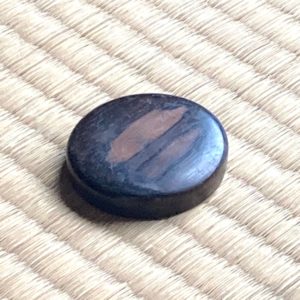
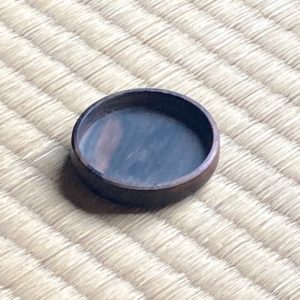
Two views of a wooden hai-fuki no futa, 灰吹の蓋, ash-blow’s lid. The structure of the lid is a shallow bowl that can contain, which is In, receptive, whereas when it is inverted, it changes to Yō, positive, and cannot contain.
This kind of lid is made of wood called Kara-ki buta, 唐木蓋, Tang-wood lid, and is made of tropical woods that include shi-tan, 紫檀, purple-sandalwood, koku-tan, 黒檀, black-sandalwood, byaku-dan, 白檀, white-sandalwood, kuro-gaki, 黒柿, black-persimmon, wood, etc.
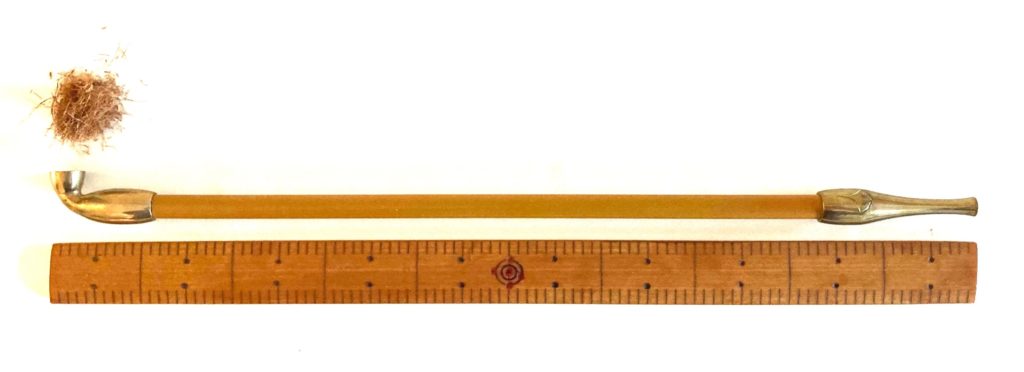
Kiseru, 煙管, smoke-pipe, with kizami tabako, 刻み煙草, fine smoke-grass, and mono-sashi, 物差し, thing-indicate, ruler, one bamboo kane-jaku, 曲尺, bend-span, 12 inches. Tobacco was introduced to Japan by the Portuguese in the 16th century, and later, most tobacco in Japan came from the state of Virginia.
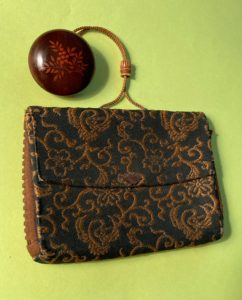
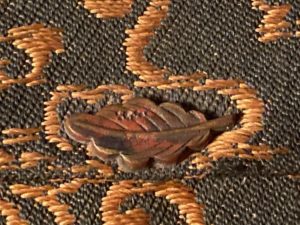
Tabako ire, 煙草入, smoke-grass-into, a kind of envelope with snap closure, to hold the thread-like kizami tabako, 刻み煙草, finely cut tobacco, in a paper wrapper. It has a ne-tsuke, 根付, root-attach, that is held by a cord with a sliding o-jime, 緒締, cord-tighten. W. 3 sun kujira-jaku. Right: detail of weaving technique, and copper snap head ‘tobacco’ leaf, with tiny ‘worm holes’.
The tabako ire, 煙草入, smoke-grass-into, envelope is made of leather covered with fabric with a pattern of tsuru sakura kara-kusa, 鶴桜唐草, crane cherry Tang-grass. The ne-tsuke, 根付, root-attach, has the form of a fuji no mi, 藤の実, wisteria ’s seed, made of hard wood with a lacquered design of nan-ten, 南天, south-heaven, nandina, held by a cord with sliding o-jime, 緒締, cord-tighten, that is made of ivory in the form of a cha-sen, 茶筅, tea-whisk. The tobacco holder is worn on the body on the outside with the cord slipped under the obi, and secured with the netsuke like a toggle. Although it could be carried in the sleeve or tucked into the front folding of the kimono, it is worn on the outside showing one’s pride of its ‘fine’ quality.
See also: Tabako Bon and the Five Elements

